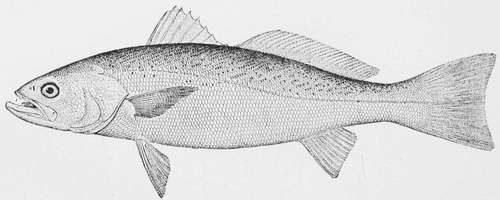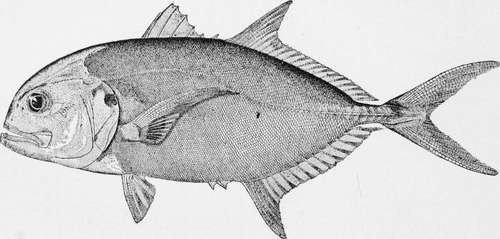The Cavalli Or Crevalle-Caranx Hippus (Gunther)
Description
This section is from the book "American Game Fishes", by W. A. Perry. Also available from Amazon: American Game Fishes: Their Habits, Habitat, and Peculiarities; How, When, and Where to Angle for Them.
The Cavalli Or Crevalle-Caranx Hippus (Gunther)
I am unable to decide to which of the species of Caranx that frequent our Southern coast the Cavalli belongs, but probably it is C. hippiis. It is a fish which affords good sport to the angler, but is of only moderate quality on the table, the flesh being somewhat oily, with black streaks, like that of the Mackerel.
In form the Cavalli is deep and compressed, with a long double dorsal fin extending to the tail, which is deeply forked. The colors change rapidly after the fish is taken from the water, green, yellow, and silvery, predominating. Eyes large, mouth ditto, with sharp conical teeth. Grows to the weight of twelve or fifteen pounds, averaging perhaps three in the spring run. It is very strong and active, fighting to the last on the hook, and dying as soon as taken. Very voracious, taking all sorts of bait, on the bottom, at midwater, or on the surface-cut-Mullet being commonly used. I have taken it with a trolling spoon, and others have taken it with a fly. A Cavalli of four or five pounds must be carefully handled on a rod, as its movements are rapid and unexpected-leaping out of the water, running under the boat, and conducting itself in the gamest fashion, so that many escape.

Common Squeeague-Cynoscioi regale.
The Cavalli usually appears at Mosquito Inlet in April, or earlier if the water is warm, in large schools, and is discovered by the commotion which it causes among the small fry, especially Mullet, which it hunts and devours incessantly, often driving them on shore. In the Indian River it is found all winter. Spawns in May, in the ocean.
Says Professor Goode: "The name of this fish is usually written and printed, 'Crevalli,' but the form in common use among the fishermen of the south, 'Cavally,' is nearer to the Spanish and Portuguese names, Cabulia and Cavalla, meaning 'horse.' It should be remembered that in South Carolina the name Crevalli is most generally applied to quite another fish-the Pompano." jordan and gilbert's description.
Crevalli, Horse Crevalli-Caranx hippos (Gunther). Olivaceous above; sides and below, silvery golden; a distinct black blotch on opercle, and one on lower rays of pectorals, the latter sometimes wanting; axil of pectoral dusky; anterior edge of dorsals black; upper edge of caudal peduncle dusky. Body oblong, the anterior profile very strongly arched. Head large and deep. Mouth large, low, and nearly horizontal below axis of body; lower jaw included maxillary extending to nearly opposite posterior border of eye. Teeth in upper jaw in a broad villiform band; an outer series of large, wide-set conical teeth. Teeth of lower jaw in one row, a distinct canine on each side of symphysis; villiform teeth on vomer; palatines and tongue. Lateral line with a wide arch, its length three-fourths that of straight part; plates not covering all of straight part. Dorsal spines short, rather stout ; procumbent spine obsolete. Gill-rakers stout, not very long, 15 below angle. Occipital keel sharp. Eye not very large, longer than snout; 4-in. head.

cavalli or crlvalle-taranx hippos.
Continue to:
- prev: Sheep's-Heads, Groupers, And Mangrove Snappers
- Table of Contents
- next: The Lady-Fish Or Bone Fish-Albula Vulpes (Goode), Albula Conoryhnchus (Gunther)
